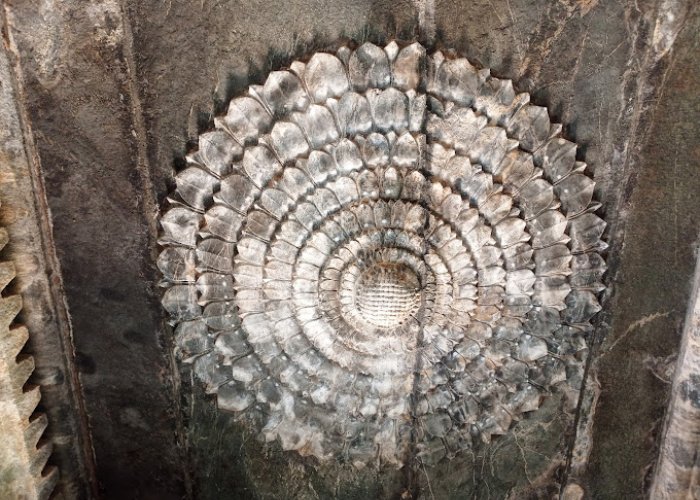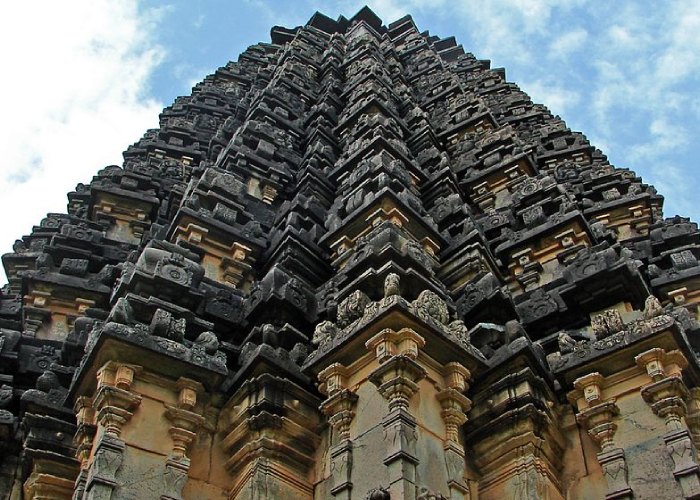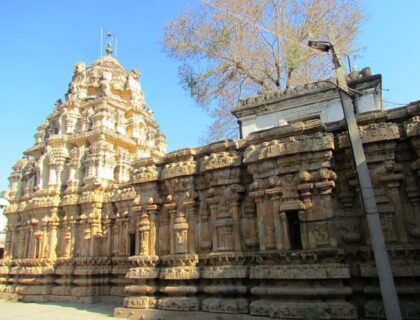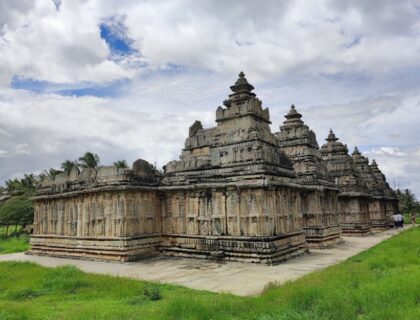Doddabasappa Temple Dambal
Doddabasappa Temple is a Lord Shiva Temple made in Western Chalukyan architectural innovation from the 12th century located in Dambal, Karnataka, India. Dambal is located in Koppal district, about 20 kilometres southeast of Gadag city and 24 kilometres southwest of Ittagi.
The Doddabassappa temple was built in 1124-26 AD and was known as the Ajjameshara temple because the builder was named Ajjayanayaka. The temple was given the name Doddabasappa because of the large bull (Doddabasappa) Nandi that stands at the temple’s entrance.
Significance of Doddabasappa Temple
The temple interior is standard in design, with a sanctum (cella), a vestibule (antarala), and a main mantapa (also known as navaranga or hall). The vestibule is the link between the sanctum and the mantapa. The Karnata Dravida architectural tradition was defined by the Western Chalukya monuments, which were regional variants of existing Dravida (South Indian) temples.
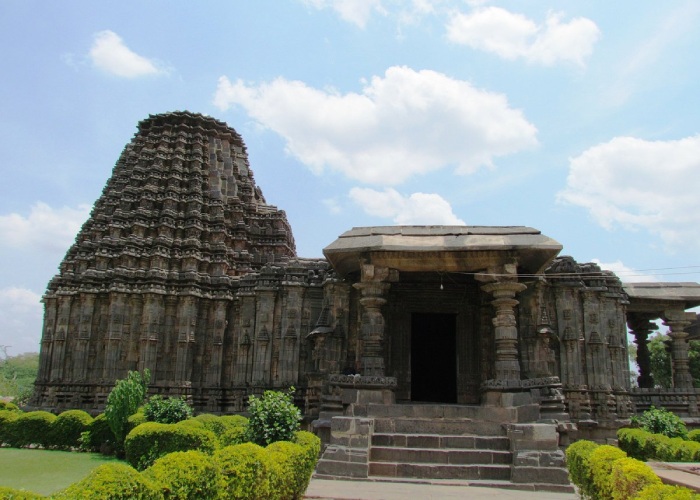
History of Doddabasappa Temple
The Doddabasappa Temple was built in the early 12th century CE by Western Chalukyas. Western Chalukya architecture, also known as Kalyani Chalukya or Later Chalukya architecture, has a distinct ornamentation style that evolved during the reign of the Western Chalukya Empire in the Tungabhadra region (covering vast areas of the Deccan Plateau) of modern central Karnataka during the 11th and 12th centuries. They also used lathe-turned stone pillars to support the roofs of the halls (mandaps).

The Architecture of Doddabasappa Temple
The Doddabasappa Temple is built with soapstone and is based on a unique 24-pointed uninterrupted stellate (star-shaped) plan. The modern stellate plans of the Bhumija shrines in central India that inspired this temple were all 32-pointed interrupted types. With the exception of the Doddabasappa temple, which can be described as a 24-pointed uninterrupted plan, no temples of the 6-, 12-, or 24-pointed stellate plans are known to exist in Karnataka or Maharashtra.

The stellate outline is interrupted by orthogonal (right-angle) projections in the cardinal directions in an ‘interrupted’ stellate plan, resulting in skipped star points.
The Doddabasappa temple represents the pinnacle of Chalukyan art, which arose from the basic Dravida architecture of South India. Its departure from the traditional Dravida plan used in the Virupaksha temple in Pattadakal is so extreme that similarities would be difficult to find without careful examination. A star is formed by rotating a square about its centre. Equidistant projections are formed by the star points. The angles and re-entrant angles formed thus form the perimeter of the shrine’s outer wall.

The pillars in this temple are finely chiselled and “complicated,” but they lack the elegance of those in Lakkundi’s Kasivisvesvara Temple. Above the shrine’s entrance is a decorative architrave with space for images of the Hindu Gods Brahma, Vishnu, and Shiva (now missing). Depending on the temple’s dedication, either Vishnu or Shiva would take centre stage in this arrangement.

The sanctum’s entrance is elaborately decorated on both sides with floral designs containing tiny images of dancers, musicians, and even a mithuna couple (Gemini). There are three images in the main mantapa (hall), one of the “five-headed” Brahma and his vehicle (vahana), the goose, and two of Surya, the Sun God.

The temple has two doorways, one facing south and one facing east, each with a porch. The east-facing door has the remains of what must have been elegant lintel decoration on either side, as well as an open hall type of pillared extension containing a large recumbent image of Nandi (bull) facing the shrine.
Important Facts About Doddabasappa Temple
- Doddabasappa Temple also known as Mailara Linga Temple, is located in Dambal, Karnataka. The temple’s presiding deity is known as Mailabesvara.
- Originally known as the Ajjameshvara Temple, it was later renamed Doddabasappa Temple in honour of the massive Nandi (bull) statue that stands at its entrance.
- Inscriptions refer to Dambal as Dharmavolal and Dharmapura. Queen Lakshmi Devi, the wife of Western Chalukya King Vikramaditya VI, is said to have ruled from Dambal, which served as a provincial capital.
- The Doddabasappa Temple Dambal faces east and comprises a sanctum, vestibule, and navaranga. The navaranga has entrance porches on the eastern and southern sides.
- The eastern entrance porch has been converted into a Nandi mandapa, which houses a massive Nandi statue, hence the temple’s name, Doddabasappa.
- The eastern entrance doorway is adorned with seven bands of decorative carvings, and the lintel depicts Gajalakshmi. A Shiva Linga can be found inside the sanctum.
- The vimana (tower) is designed with a 24-pointed stellate (star-shaped) plan, whereas the hall is designed with a 32-pointed stellate plan.
- This stellar design is continued with the temple’s shikhara (tower), which has seven tiers. The shikhara’s upper tiers resemble cogged wheels with 48 dents.
- The Doddabasappa Temple exterior walls are decorated with pilasters and turrets placed at regular intervals, adding to the temple’s architectural and aesthetic appeal.
Best Time to Visit Doddabasappa Temple
This place is very heavenly and spiritual, and you can visit it all year. The best time to visit this temple, however, is during the monsoon and winter seasons. During the monsoon season, this location receives moderate to heavy rainfall, making it appear heavenly with its greenery and bringing freshness elsewhere.
Famous Festivals In Doddabasappa Temple
- Shravana: For happiness and wealth, many fasts, offerings, and mantras are performed during the fifth month of the Hindu calendar, known as Shravana.
- Mahashivaratri is a fasting ritual that takes place in the last week of February. It is reminiscent of Lord Shiva bringing Goddess Parvati with him. A Grand Celebration is arranged by priests and the temple committee.
How to Reach Doddabasappa Temple
By Air: Bangalore International Airport is approximately 443 kilometres away, and Hubli Airport is approximately 80 kilometres away. Tourists can take a taxi or a bus from the airport to Dambal or Gadag.
By Rail: Dambal’s nearest railway station is Gadag. Tourists can hire an auto or take a bus from the railway station to
By Road: Dambal is 21 kilometres from Gadag. Gadag is well connected by road to all Karnataka cities. Buses to Dambal are available from Gadag.
Also Read – Balligavi Kedareshvara Temple
Support Us
If our content helps you even 1% in gaining information about the temple, please support us by contributing any amount, our UPI ID is - q417999792@ybl Or pay using QR CODE >>> Click Now
Location
Facilities
- Drinking Water
- Pooja Item Shops
- Prasad Shops
- Restaurants Nearby
- Resting Room





